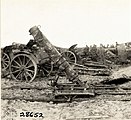
A mortar is usually a simple, lightweight, man-portable, muzzle-loaded weapon, consisting of a smooth-bore metal tube fixed to a base plate with a lightweight bipod mount and a sight. Mortars launch explosive shells in high-arching ballistic trajectories. Mortars are typically used as indirect fire weapons for close fire support with a variety of ammunition.

Schwerer Gustav was a German 80-centimetre (31.5 in) railway gun. It was developed in the late 1930s by Krupp in Rügenwalde as siege artillery for the explicit purpose of destroying the main forts of the French Maginot Line, the strongest fortifications in existence at the time. The fully assembled gun weighed nearly 1,350 tonnes, and could fire shells weighing 7 t to a range of 47 km (29 mi).

The Nebelwerfer was a World War II German series of weapons. They were initially developed by and assigned to the Army's Nebeltruppen. Initially, two different mortars were fielded before they were replaced by a variety of rocket launchers ranging in size from 15 to 32 centimetres. The thin walls of the rockets had the great advantage of allowing much larger quantities of gases, fluids or high explosives to be delivered than artillery or even mortar shells of the same weight. With the exception of the Balkans Campaign, Nebelwerfer were used in every campaign of the German Army during World War II. A version of the 21 cm (8.3 in) calibre system was adapted for air-to-air use against Allied bombers.

The 7.58 cm Minenwerfer a.A., also 7.58 cm Leichter Minenwerfer, was a German First World War mortar.
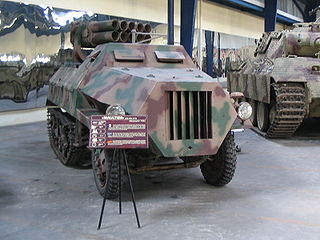
The German Panzerwerfer refers to either of two different types of half-tracked multiple rocket launchers employed by Nazi Germany during the Second World War. The two self-propelled artillery vehicles are the 15 cm Panzerwerfer 42 auf Selbstfahrlafette Sd.Kfz.4/1 and 15 cm Panzerwerfer 42 auf Schwerer Wehrmachtsschlepper.

The 240 mm trench mortar, or Mortier de 240 mm, was a large calibre mortar of World War I. An original French design, it was developed by Batignolles Company of Paris and introduced in 1915.
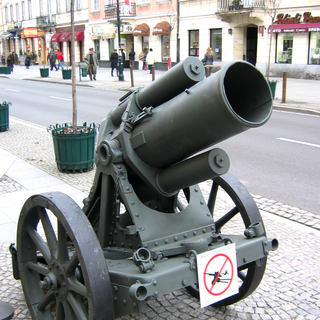
The 25 cm schwerer Minenwerfer, often abbreviated as 25 cm sMW, was a heavy mine shell launching trench mortar developed for the Imperial German Army in the first decade of the 20th century.

The 17 cm mittlerer Minenwerfer was a mortar used by Germany in World War I.

The 10 cm Nebelwerfer 35 was a heavy mortar used by Germany during World War II. Much like the American M2 4.2 inch mortar it was intended to deliver chemical munitions, such as gas and smoke shells. Unlike the American weapon it appears to have had an ordinary high-explosive shell from the beginning. It was of conventional design, and was virtually a scaled-up 8 cm GrW 34. It broke down into the standard three loads for transport. The tube weighed 31.7 kg (70 lb), the baseplate 36.3 kg (80 lb) and the bipod 32.2 kg (71 lb). Each could be man-packed for some distance, but small handcarts were issued for longer distances. Each mortar squad consisted of a squad leader, three gunners and three ammunition bearers.

The 10 cm Nebelwerfer 40 was a heavy mortar used by Germany during the Second World War. Much like the American M2 4.2 inch mortar it was intended to deliver chemical munitions, such as gas and smoke shells, as well as ordinary high-explosive shells. It was derived from Rheinmetall's Nebelwerfer 51 and 52 prototypes of the late 1930s which were attempts to develop a more accurate and longer-ranged mortar than the 10 cm Nebelwerfer 35. The NbW 40 is one of the better examples of German overengineering since it fired a slightly heavier bomb over twice as far as the NbW 35, but weighed almost eight times more than the earlier model.

The 22.5 cm Minenwerfer M 15 was a heavy mortar used by Austria-Hungary in World War I. It was developed by Böhler as an alternative to the German Ehrhardt 25 cm schwere Minenwerfer which Böhler was having problems building under license. It was a muzzle-loading, smooth-bore mortar that had no recoil system whatsoever. The entire mortar had to be levered around to aim at new targets. It was not particularly accurate and bombs often fell over in flight and landed on their sides so they used time instead of contact fuzes. It fired high-explosive and gas shells. For transport two wheels from the Gebirgsgechütz M 99 were used.

The 9 cm Minenwerfer M 14 was a light mortar used by Austria-Hungary in World War I. Originally named the '1-kg Minenwerfer', it was designed by the Army's own Technisches und Administratives Militär-Komitee (TMK) in an effort to quickly satisfy the demand from the front for a light mortar.

The 28/32 cm Nebelwerfer 41 was a German multiple rocket launcher used in the Second World War. It served with units of the so-called Nebeltruppen, the German equivalent of the U.S. Army's Chemical Corps. The Nebeltruppen had responsibility for poison gas and smoke weapons that were used instead to deliver high-explosives during the war. The name "Nebelwerfer" is best translated as "Smoke Mortar". It saw service from 1941–45 in all theaters except Norway and the Balkans.

Albrecht mortars or Albrecht Schwerer Minenwerfers were a series of wooden heavy mortars used by the Imperial German Army during the First World War.

The 10.5 cm Gebirgshaubitze L/12 was a mountain howitzer used by Germany, Bulgaria, and the Ottoman Empire during World War I.

The 24 cm schwere Flügelminenwerfer IKO or 24 cm sFIMW IKO was a heavy mortar used by the Imperial German Army during the First World War.
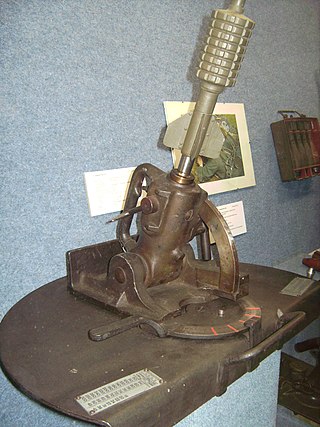
The kleineGranatenwerfer 16 or Gr.W.16(Small Grenade Launcher Model 1916) in English, was an infantry mortar used by the Central Powers during the First World War. It was designed by a Hungarian priest named Father Vécer and was first used by the Austro-Hungarian Army in 1915. In Austro-Hungarian service, they received the nickname "Priesterwerfers". In 1916 Germany began producing a modified version under license for the Imperial German Army.
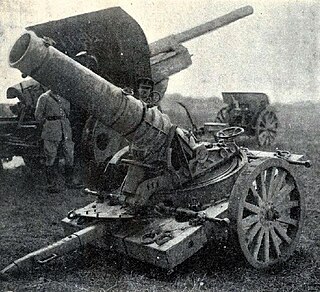
The 24 cm schwere FlügelMinenWerfer Albrecht, or 24 cm sFIMW 17 Albrecht, was a heavy mortar used by the Imperial German Army during the First World War.

The Mortier de 58 T N°1 bis sometimes referred to as Lance Torpilles was an early French medium trench mortar. It was used by both the French Army and Italian Army during the First World War.
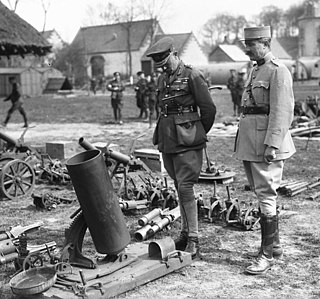
The 24 cm schwerer LadungsWerfer Ehrhardt shortened to 24 cm sLW Ehrhardt,('24 cm heavy charge thrower Ehrhardt' in English) was a heavy mortar used by the Imperial German Army during the First World War.







